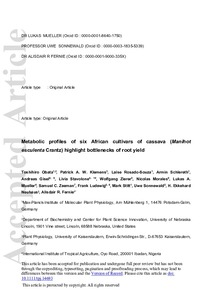| dc.contributor.author | Obata, T. |
| dc.contributor.author | Klemens, P.A.W. |
| dc.contributor.author | Rosado-Souza, L. |
| dc.contributor.author | Schlereth, A. |
| dc.contributor.author | Gisel, A. |
| dc.contributor.author | Stavolone, L. |
| dc.contributor.author | Zierer, W. |
| dc.contributor.author | Morales, N. |
| dc.contributor.author | Muller, L.A. |
| dc.contributor.author | Zeeman, S.C. |
| dc.contributor.author | Ludewig, F. |
| dc.contributor.author | Stitt, M. |
| dc.contributor.author | Sonnewald, U. |
| dc.contributor.author | Neuhaus, H.E. |
| dc.contributor.author | Fernie, A.R. |
| dc.date.accessioned | 2020-05-28T12:33:33Z |
| dc.date.available | 2020-05-28T12:33:33Z |
| dc.date.issued | 2020 |
| dc.identifier.citation | Obata, T., Klemens, P.A., Rosado‐Souza, L., Schlereth, A., Gisel, A., Stavolone, L., ... & Fernie, A.R. (2020). Metabolic profiles of six African cultivars of cassava (Manihot esculenta Crantz) highlight bottlenecks of root yield. The Plant Journal, 1-40. |
| dc.identifier.issn | 0960-7412 |
| dc.identifier.uri | https://hdl.handle.net/20.500.12478/6849 |
| dc.description.abstract | Cassava is an important staple crop in sub‐Saharan Africa, due to its high productivity even on nutrient poor soils. The metabolic characteristics underlying this high productivity are poorly understood including the mode of photosynthesis, reasons for the high rate of photosynthesis, the extent of source/sink limitation, the impact of environment, and the extent of variation between cultivars. Six commercial African cassava cultivars were grown in a greenhouse in Erlangen, Germany, and in the field in Ibadan, Nigeria. Source leaves, sink leaves, stems and storage roots were harvested during storage root bulking and analyzed for sugars, organic acids, amino acids, phosphorylated intermediates, minerals, starch, protein, activities of enzymes in central metabolism and yield traits. High ratios of RuBisCO:phosphoenolpyruvate carboxylase activity support a C3 mode of photosynthesis. The high rate of photosynthesis is likely to be attributed to high activities of enzymes in the Calvin–Benson cycle and pathways for sucrose and starch synthesis. Nevertheless, source limitation is indicated because root yield traits correlated with metabolic traits in leaves rather than in the stem or storage roots. This situation was especially so in greenhouse‐grown plants, where irradiance will have been low. In the field, plants produced more storage roots. This was associated with higher AGPase activity and lower sucrose in the roots, indicating that feedforward loops enhanced sink capacity in the high light and low nitrogen environment in the field. Overall, these results indicated that carbon assimilation rate, the K battery, root starch synthesis, trehalose, and chlorogenic acid accumulation are potential target traits for genetic improvement. |
| dc.description.sponsorship | Bill & Melinda Gates Foundation |
| dc.description.sponsorship | University of Nebraska‐Lincoln |
| dc.format.extent | 1-40 |
| dc.language.iso | en |
| dc.subject | Cassava |
| dc.subject | Yields |
| dc.subject | Photosynthesis |
| dc.subject | Enzyme Activity |
| dc.subject | Nitrogen Metabolism |
| dc.subject | Starch |
| dc.subject | Chlorogenic Acid |
| dc.title | Metabolic profiles of six African cultivars of cassava (Manihot esculenta Crantz) highlight bottlenecks of root yield |
| dc.type | Journal Article |
| cg.contributor.crp | Roots, Tubers and Bananas |
| cg.contributor.affiliation | Max‐Planck‐Institute of Molecular Plant Physiology |
| cg.contributor.affiliation | University of Kaiserslautern |
| cg.contributor.affiliation | International Institute of Tropical Agriculture |
| cg.contributor.affiliation | University of Erlangen‐Nuremberg |
| cg.contributor.affiliation | Boyce Thompson Institute, USA |
| cg.contributor.affiliation | Institute of Molecular Plant Biology, Switzerland |
| cg.contributor.affiliation | Institute for Biomedical Technologies, Italy |
| cg.coverage.region | Africa |
| cg.coverage.region | West Africa |
| cg.coverage.country | Nigeria |
| cg.coverage.hub | Headquarters and Western Africa Hub |
| cg.researchtheme | Biotech and Plant Breeding |
| cg.identifier.bibtexciteid | OBATA:2020 |
| cg.isijournal | ISI Journal |
| cg.authorship.types | CGIAR and advanced research institute |
| cg.iitasubject | Agronomy |
| cg.iitasubject | Cassava |
| cg.iitasubject | Food Security |
| cg.iitasubject | Food Systems |
| cg.iitasubject | Plant Breeding |
| cg.iitasubject | Plant Health |
| cg.iitasubject | Plant Production |
| cg.iitasubject | Value Chains |
| cg.journal | The Plant Journal |
| cg.notes | Open Access Article; Published online: 04 March 2020 |
| cg.accessibilitystatus | Open Access |
| cg.reviewstatus | Peer Review |
| cg.usagerightslicense | Creative Commons Attribution 4.0 (CC BY 0.0) |
| cg.targetaudience | Scientists |
| cg.identifier.doi | https://dx.doi.org/10.1111/tpj.14693 |
| cg.iitaauthor.identifier | ANDREAS GISEL: 0000-0001-7218-9488 |
| cg.iitaauthor.identifier | LIVIA STAVOLONE: 0000-0002-0691-1302 |
| cg.noniitaauthor.identifier | Lukas Muller: 0000-0001-8640-1750 |
| cg.noniitaauthor.identifier | Uwe Sonnewald: 0000-0003-1835-5339 |
| cg.noniitaauthor.identifier | Alisdair Fernie: 0000-0001-9000-335X |

